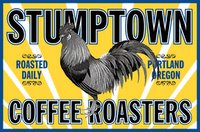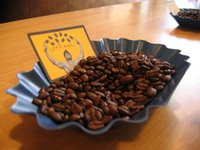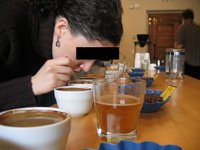Cupping at Stumptown
 6 of us EPsters met up at the new-ish Stumptown Annex on Belmont at 11AM on Sunday, January 15, 2006. Cheesy T is not in attendance 'cause she's not too into coffee and Stumptown can only accommodate 6 at the cuppings (thanks Cheesy T for sacrificing for the good of EP, we missed you!!). Hungry T, Miss Tasty, Smooth Melon, Scoop, JH, and VP are in attendance.
6 of us EPsters met up at the new-ish Stumptown Annex on Belmont at 11AM on Sunday, January 15, 2006. Cheesy T is not in attendance 'cause she's not too into coffee and Stumptown can only accommodate 6 at the cuppings (thanks Cheesy T for sacrificing for the good of EP, we missed you!!). Hungry T, Miss Tasty, Smooth Melon, Scoop, JH, and VP are in attendance.We get there a touch early, but can't begin until 11AM, even though we fill all 6 spots for the cupping. The intense aromas make it hard to wait. While suffering through the smell of the sweet, sweet bean, we check out the display of grinders and brewers from both past and present, some of us wondering 'how the hell does that machine work??' Finally, 11AM hits, and the ceremony begins...
 Our host (whose name I didn't catch) begins by setting 6 small blue trays on the counter, followed by 18 small white bowls and 6 clear glass cups. Then comes the coffee. Our host (who is both knowledgeable and friendly) asks if we have any requests.
Our host (whose name I didn't catch) begins by setting 6 small blue trays on the counter, followed by 18 small white bowls and 6 clear glass cups. Then comes the coffee. Our host (who is both knowledgeable and friendly) asks if we have any requests.  We leave it up to him, but do request the house blend as a sort of control. He pours six different kinds of beans into the six blue trays, and places a card into each one, listing the name of the coffee.
We leave it up to him, but do request the house blend as a sort of control. He pours six different kinds of beans into the six blue trays, and places a card into each one, listing the name of the coffee.Our host then begins to grind. A small scoop of each type of bean is ground and divided among 3 of the white bowls, which means there are 18 bowls sitting around the bar. But I am getting a bit ahead of myself. Here is the rundown of the coffees we were presented (for more info on the coffees themselves, check out Stumptown.com)...
- Colombia La Esparanza
- El Salvador Peaberry Reserve
- House Blend
- Kenya AA Thageini
- Panama Esmeralda Especial
- Sumatra Mandehling Grade 1
So, the first step, we are told, is to note the dry aroma. We hold the bowls, give 'em a little shake, and plunge our noses in. We work our way from the right side of the bar to the left, smelling each coffee in succession (this corresponds to 'top to bottom' on the list of coffees above, by the way).
 Step two is to note the wet aroma. Hot water is added to each of the 18 bowls, bringing the level nearly up to the rim. Hot water is also added to the 6 glass cups (one for each coffee). After a few minutes, a cap has formed atop the water. At this point, we stop being passive
Step two is to note the wet aroma. Hot water is added to each of the 18 bowls, bringing the level nearly up to the rim. Hot water is also added to the 6 glass cups (one for each coffee). After a few minutes, a cap has formed atop the water. At this point, we stop being passive observers and before active participants. There are spoons for each of us. We now break the cap. This is the point where the aroma is most pronounced. With the spoon in eating position, we plunge the cap of grounds slowly and gently back into the liquid. Rolling the spoon, we smell the exterior, which is now coated in foam and grounds. This is where the magic is. What aromas and sensations! Between each of the 6 types of coffee, we rinse our spoons in the cups of hot water (we don't want to cross contaminate our coffees, do we?).
observers and before active participants. There are spoons for each of us. We now break the cap. This is the point where the aroma is most pronounced. With the spoon in eating position, we plunge the cap of grounds slowly and gently back into the liquid. Rolling the spoon, we smell the exterior, which is now coated in foam and grounds. This is where the magic is. What aromas and sensations! Between each of the 6 types of coffee, we rinse our spoons in the cups of hot water (we don't want to cross contaminate our coffees, do we?).
 Step three, naturally, is to taste. Our host scrapes out any remaining floating grounds out of the bowls with two spoons. He then demonstrates how to taste. Fill your spoon with coffee, and slurp it up. Sounds simple, right? There is a bit of a trick... there are tastebuds all over your mouth, so you have to 'vaporize' (for lack of a better word) the coffee by slurping it with GREAT force into your mouth. Let me just say I have NEVER heard a louder slurp in my life. No matter how hard we try, we are not as loud (and we DO try, believe me). We are given the option to spit into a paper cup, and as I had plenty of coffee at breakfast, I do just that.
Step three, naturally, is to taste. Our host scrapes out any remaining floating grounds out of the bowls with two spoons. He then demonstrates how to taste. Fill your spoon with coffee, and slurp it up. Sounds simple, right? There is a bit of a trick... there are tastebuds all over your mouth, so you have to 'vaporize' (for lack of a better word) the coffee by slurping it with GREAT force into your mouth. Let me just say I have NEVER heard a louder slurp in my life. No matter how hard we try, we are not as loud (and we DO try, believe me). We are given the option to spit into a paper cup, and as I had plenty of coffee at breakfast, I do just that.
Overall, a great EP field trip. We learned a lot and had a great time. I'm going to let my fellow EPsters comment on their favorites. My top pick was the Panama Esmeralda Especial. Floral, citrus, acid, and truly unique amongst the others.

0 Comments:
Post a Comment
<< Home